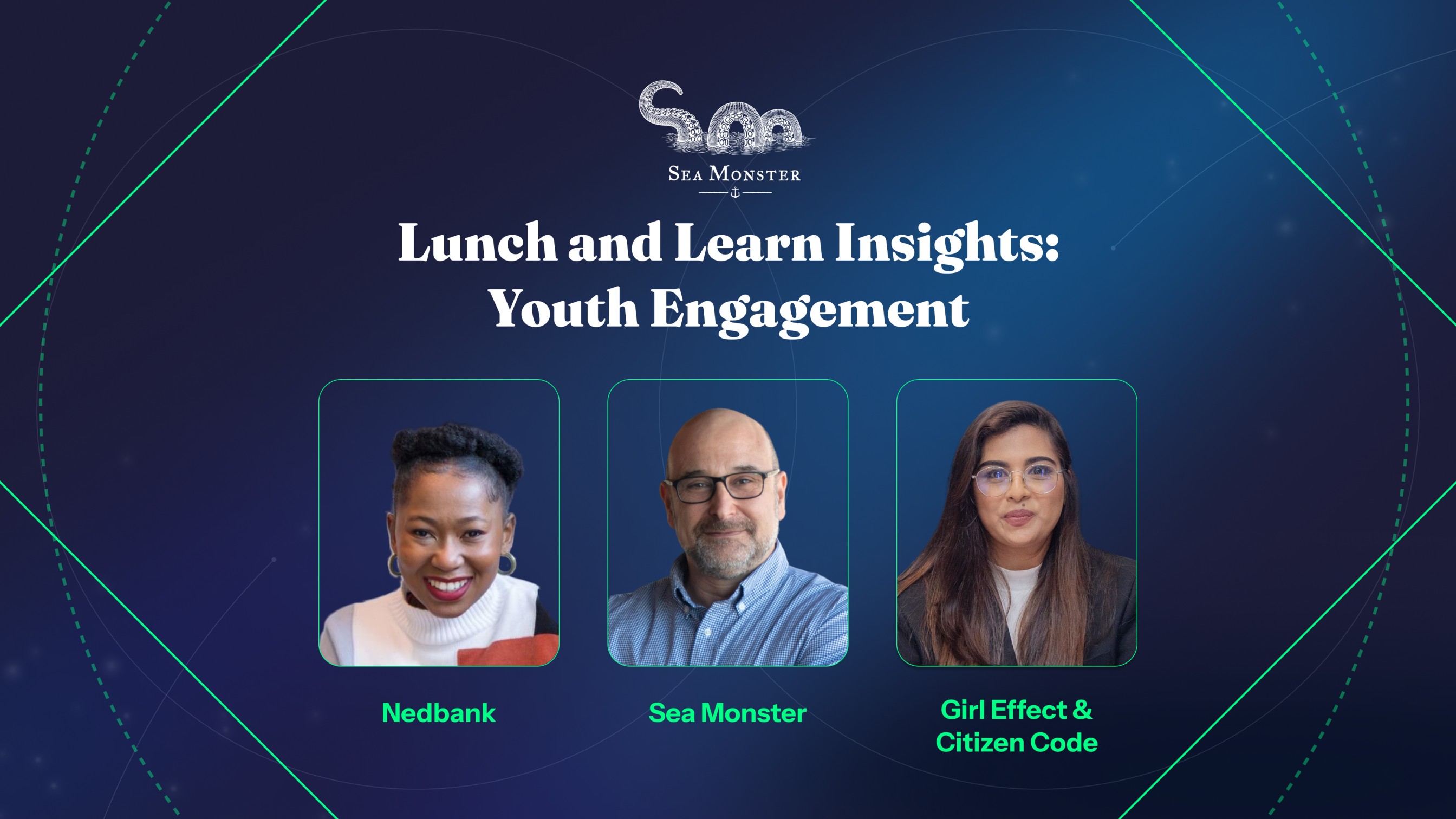Most brands think they have a youth engagement problem. The real issue? They're using strategies designed for audiences that no longer exist. In July, Sea Monster brought together Glenn Gillis (CEO, Sea Monster), Lisa Adams (Founder, Citizen Code), and Keketso Makape (Head of Strategy, Nedbank) to discuss what's actually working when connecting with younger audiences in South Africa. Here are the main takeaways.
The conversation revealed surprising insights about why traditional marketing approaches are failing with younger audiences, and more importantly, what forward-thinking brands are doing differently to build genuine relationships with their future customers. Here are the key insights.
The shifting landscape of youth connection
Connecting with young audiences has become one of the most complex challenges facing brands today. Traditional marketing approaches that worked for previous generations are showing diminishing returns, while young people increasingly gravitate toward platforms and experiences that offer genuine participation rather than passive consumption.
The numbers paint a clear picture of both the challenge and the opportunity. In South Africa, young people represent a significant portion of the population - if every eligible person aged 18-35 registered to vote, they would account for 60% of the electorate. Yet this same demographic faces a 46.5% unemployment rate and often feels disconnected from the brands and institutions trying to reach them.
This disconnect is particularly evident in sectors like financial services, where despite significant marketing investment, trust remains elusive. Recent research shows that 54% of Gen Z believe banks are trying to trick them, 46% say all banks feel the same, and 41% remain uncomfortable with online banking despite being digital natives.
Learning from policy makers
Insights from recent parliamentary discussions on youth policy offer interesting parallels to the marketing world. Lisa Adams, founder of Citizen Code and a parliamentary advisor on youth engagement, observed something telling during national youth debates:
"When young people sit in the room, things become more honest, and they become more real," noted Minister Chikunga.
This observation highlights a broader pattern: many decisions about young people, whether in policy or marketing, are still made without their direct input. The contrast between conversations about youth and conversations with youth often reveals significant gaps in understanding their actual needs and preferences.
"Young South Africans don't want to be passive recipients of economic change," Adams explained. "They want to be actively engaged."
The rise of collaborative platforms
While brands have traditionally focused on broadcasting messages to young audiences, a new model is emerging based on collaboration and co-creation. Gaming platforms have become unexpected laboratories for this approach, offering spaces where brands and young people can build experiences together.
Nedbank's Chow Town on Roblox provides an instructive case study. The restaurant management game teaches entrepreneurship and financial literacy, but its development process reveals something important about youth engagement. When players requested features like hired staff, the development team added them. When the community suggested improvements, those suggestions were implemented.
The results were notable: 82% positive user ratings, average engaged session times of 14+ minutes, and a 30% increase in youth banking product uptake for Nedbank. But perhaps more significantly, the experience demonstrated how responsive development can create genuine engagement.
"There's a keenness for the youth to understand banks, but the knowledge gap is quite big," explains Keke, Head of Marketing Strategy at Nedbank. "They need really practical solutions."
Gaming as an engagement medium
Gaming platforms have emerged as particularly effective spaces for youth engagement, not merely because young people spend time there, but because these environments naturally encourage active participation. Unlike traditional media, games require players to make decisions, solve problems, and often collaborate with others.
International examples support this trend. Fidelity's Pancake Empire Tower Tycoon on Roblox has attracted millions of visits while teaching investment concepts through restaurant management gameplay. ING Bank Poland created an entire virtual city where teens earn currency through various tasks, learning financial responsibility in a consequence-free environment.
These experiences succeed because they embed learning within engaging activities rather than presenting education as a separate objective. Players develop skills organically while pursuing goals they find inherently interesting.
The authenticity factor
One pattern emerging from successful youth engagement initiatives is the importance of acknowledging limitations rather than projecting expertise.
"If we show vulnerability as a corporate and say, 'we're not perfect,' people gain confidence. Then we start a conversation," observes Glenn, CEO of Sea Monster.
This approach contrasts with traditional marketing's emphasis on authority and polish. Young audiences, having grown up with unprecedented access to information and peer reviews, tend to respond more positively to brands that admit uncertainty and demonstrate willingness to learn alongside their communities.
System integration challenges
Beyond individual brand experiences, research suggests young people are looking for more integrated approaches to the services they use.
"The opportunity is making their experiences simpler," notes Adams. "We need to work together so they don't have to jump between disconnected systems. Let's create seamless pathways."
This insight points toward a broader shift from campaign-based marketing toward platform-based engagement. Rather than creating isolated touchpoints, successful youth engagement increasingly involves building sustained relationships through interconnected experiences.
Gaming platforms naturally support this integration. Within virtual worlds, young people can explore different aspects of their lives; career development, financial planning, social causes, without switching between disconnected services or interfaces.
The key trends
Several trends are becoming apparent as brands experiment with new approaches to youth engagement:
- Co-creation over communication: The most successful initiatives involve young people in shaping experiences rather than simply consuming them.
- Sustained engagement over campaign bursts: Platform-based relationships are proving more effective than traditional campaign cycles.
- Practical value over inspirational messaging: Young audiences respond more positively to experiences that develop real skills or provide tangible benefits.
- Responsive development: The ability to adapt based on community feedback appears crucial for maintaining engagement over time.
The broader context
These developments in youth engagement reflect larger changes in how young people interact with institutions, brands, and each other. Having grown up with social media, user-generated content, and collaborative online spaces, many expect to participate in shaping the experiences they encounter.
This expectation extends beyond entertainment into areas like education, career development, and financial services. The brands successfully connecting with young audiences are those that have found ways to honour this expectation for participation while delivering genuine value.
As this demographic continues to mature into the dominant economic force, understanding these preferences becomes increasingly important for long-term business success. The companies that figure out how to collaborate effectively with young people today are likely to be the ones that maintain their loyalty as they become the primary market tomorrow.
Looking ahead
The evolution of youth engagement strategies reflects broader changes in technology, communication, and social expectations. Gaming platforms represent just one avenue among many emerging approaches, but they offer valuable insights into what authentic collaboration between brands and young people might look like.
As more brands experiment with these collaborative models, we're likely to see further innovation in how companies build relationships with their future customers, employees, and stakeholders.


.svg)
.svg)






.gif)
